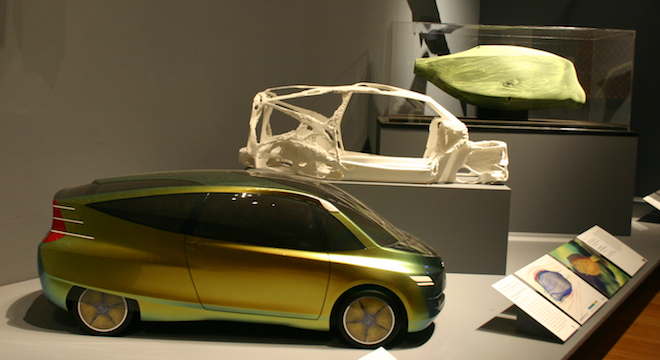STEPHEN BEALE
There’s something fishy about the design of futuristic, eco-friendly cars like the Toyota Prius, Mercedes Benz concept Bionic and the Nissan concept EPORO, namely that their designs seem to be inspired by marine animals. In the case of the Bionic, one animal in particular was the model: The humble boxfish.
This is the unlikely story of how the little fish came to be seen as a symbol of technological progress and prowess by one of the world’s most prestigious automobile manufacturers.
Boxfish can be found in reef habitats from Puerto Rico to Hawaii and, like other tropical fish, they are brilliantly colored–some are sunflower yellow with black polka dots, others have leopard-spotted electric-blue bellies.
But boxfish would not win any Caribbean beauty contests. The front two thirds of their bodies are encased in a bony carapace that come in all sorts of shapes–some triangular, others rectangular or even trapezoidal. Ridges jut out over their eyes and bony keels stick outward from their bellies and backs.
In other words, it’s the last kind of fish one would expect to be aerodynamically smooth.
But appearances can be deceiving, said Malcolm Gordon, a professor of fish biology at UCLA.
Gordon and a team of researchers at UCLA and Caltech spent the better part of 15 years studying the movement of boxfish in water, with a grant from the Office of Naval Research, which was interested in finding new models for its next generation of unmanned subs, also known as autonomous underwater vehicles, or AUVs.
Gordon and his colleagues found that the boxfish is an exceptionally stable and smooth swimmer.
The secret to its stability are those ugly bony keels along the belly and backs. These keels generate whirling masses of water, or vortices, which balance the forces around the fish, enabling it to stick to its straight path through the water.
This balancing effect, researchers found, is similar to the flow of air around the Delta-shaped wings high-speed aircraft, like the Concorde SST and the North American XB-70 Valkyrie supersonic bomber.
One other striking feature of the boxfish is how smooth it can swim. Gordon and his colleagues determined that its body had a lower than expected drag coefficient, which is a technical way of saying that it can move through the water with little resistance from the water itself.
That is because of the way the shape of the carapace interacts with the fluid immediately surrounding it, which is known as the “boundary layer.” Over millions of years of evolution, the particular shapes of the box fish have been developed in such a way as to draw the boundary layer closer to the body of the fish, thereby reducing its drag through the water, according to Gordon.
Soon after publishing a paper disclosing their findings, several years ago, Gordon says their research generated interest from an unexpected quarter.
“Shortly thereafter I get a sort of a cryptic phone call from someone working for the Goodyear Tire Company in Detroit,” Gordon said. The caller wanted a copy of the research paper.
And then, Gordon and his co-authors thought nothing else of it, until DaimlerChrysler unveiled the Mercedes-Benz Bionic in 2005.
That low drag coefficient, it turns out, had caught the attention of engineers at DaimlerChrysler, who wanted to design and build a new concept car based on principles from nature.
Designs with lower resistance to airflow mean higher fuel efficiency, especially at highway speeds when as much as 60 percent of fuel is consumed overcoming air resistance.
Other marine animals, such as dolphins and penguins, have low drag coefficients as well, but the boxfish is a better model for engineering because its rigid body structure and square-shape are more analogous to cars, according to Gordon.
“What you’ve got to remember is that nature has had a lot of time to do a lot of experiments,” Gordon said.
Working with clay models based on the boxfish, engineers in DaimlerChrysler’s Research
Body and Powertrain unit incorporated many of the features of the boxfish. When the models were used to build a full-scale car, the result was a two-door compact car with a bulging front windshield that extended over part of the roof, wing-shaped windows running along its sides, and a large tailgate on the side.
When it was unveiled, Gunter Holzel, director of the Concept and Research Vehicle Construction at DaimlerChrysler, boasted that the car was “one of the most aerodynamically efficient vehicles of its size.”
The engineers had crafted a Bionic Car had a drag coefficient of .19, in contrast to a typical car, which has a drag coefficient around .30 or higher. A Ferrari, for example, ranges from .32 to .42, depending on the year and model. Still, Mercedes Benz never produced the car and it exists purely to this day as an untested concept.
That being the case, Gordon says he has seen the concepts taken from the structure of boxfish incorporated in other new car designs, most notably the Prius, the best-selling hybrid car in America. Even Gordon drives one.
“Little did we know,” Gordon said.
But Greg Thome, a spokesman for Toyota, denied that the design for the Prius had been inspired by either the boxfish or the Bionic Car.
“It could be completely coincidental,” Thome said, when asked to explain the similarities.









